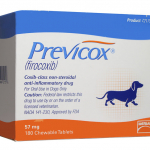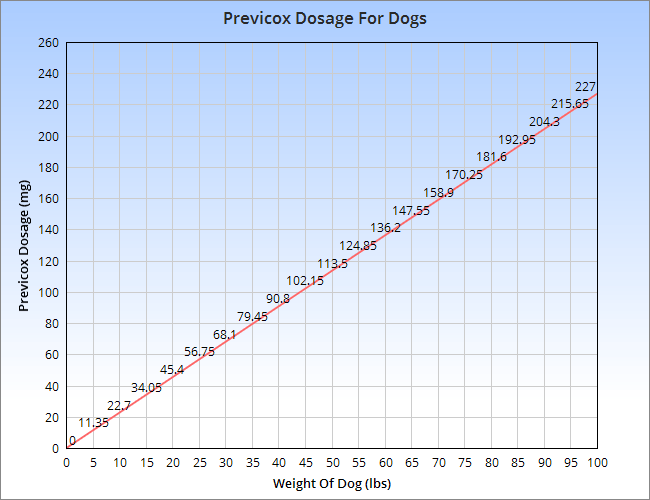If you’re the owner of a senior dog, chances are you’re keeping an eye out for a lot of potential symptoms. It only makes sense. Just like older people, as they age, dogs are at a higher risk of developing conditions like:
- heart disease
- dementia
- or even osteoarthritis.
The latter one is potentially the most heartbreaking of them all. The joints between bones are surrounded by a layer of connective tissues called cartilage. This layer, over the years, begins to break down and results in the bones rubbing against one another, causing intense distress and pain.
Eventually, it will hurt to walk, climb stairs, run, jump, or otherwise live an active, healthy lifestyle. While there is no cure for the condition, there are some treatments that you can seek out to alleviate his or her pain.
What is Previcox for dogs?

When you’re in pain, chances are you rummage through your medicine cabinet for a pain-reliever, also known in medical circles as a non-steroidal anti-inflammatory.
Dogs affected by osteoarthritis can’t go searching through the drug cabinet for a pill and will need your help on this one, and that’s usually where Previcox comes in.
If your dog is diagnosed with osteoarthritis, he’ll steadily begin to experience inflammation of the joints that reduces mobility and can cause quite a bit of pain.
This happens because of an enzyme called cyclooxygenase. While there are two types of this enzyme, COX-1, and COX-2, the first of these is beneficial to the functioning or your internal organs. The second, however, produces prostaglandins that actively harm both people and pets by acting as the cause of the inflammation.
COX-2 production inhibitor
Therefore, in order to treat osteoarthritis, veterinarians and scientists can’t wrap joints in new layers or cartilage, but they can inhibit COX-2 production to limit pain, and they can prescribe medications like Previcox to help do the job.
Similar to something like aspirin, Previcox is an anti-inflammatory that works quickly after ingestion and relieves pain by doing the following:
- reduces swelling in painful joints
- relieves discomfort
- reduces inflammation after surgery
- can reduce fevers.
All of this is accomplished due to the inhibition of COX-2. It does this by using a chemical called Firocoxib, an NSAID that was first approved for use in horses but has since quickly spread to use in dogs as well. It’s incredibly handy and great for managing severe pain in older dogs but isn’t as readily accessible as human medications, and has to be prescribed by a veterinarian.
What is Previcox for dogs used for?
If you’ve ever experienced, or know someone who has suffered from osteoarthritis, then you know that it’s not a pleasant experience. Joints ache, it’s difficult to move around, you feel stiff all the time, and doing simple, routine tasks like writing, playing video games, or playing sports becomes an exercise in frustration.

Dogs experience the same stress and trauma, with none of the accessibility to drug options that humans have. Especially hunting or herding breeds that love to run and play outside, can find their mobility drastically reduced, which can limit their desire to go outdoors.
Excessive lethargy in dogs can lead to some unwanted side effects, such as:
- increased laziness
- weight gain
- depression.
Check out a few hints and tips for dogs suffering from osteoarthritis in this video:
Previcox is particularly great for pets who are struck with the degenerative disease early in their lives due to other medical complications like infections. Using an NSAID to alleviate their suffering can improve their quality of life dramatically; since moderate to severe levels of pain can result in a loss of appetite, inability to fall asleep, and more.
In milder cases, Previcox can potentially eliminate pain entirely between doses, which can give your dog the incentive and encouragement it needs to go for a nice long walk on a beautiful day.
Since the drug works as a pain reliever as well, it may also be prescribed by a veterinarian after your pet suffers an external injury. Tissue damage can lead to inflammation, which would be treated by the use of this drug.
If the pain is alleviated, your dog can still live a healthy, happy life until she is fully healed from her injury. If you notice that your dog is routinely in pain, a trip to the vet may be in order.
How do I get Previcox for my dog?

Previcox is available to your dog solely via a prescription by a licensed veterinarian.
This is primarily due to the potential for abuse and side effects. However, pain is not the only requirement. There are many factors that could limit the odds of your vet filling out a prescription for the drug.
Puppies
Puppies need to be seven weeks of age or older before becoming eligible for the use of this drug. This shouldn’t be a problem since puppies at that age don’t typically display symptoms of degenerative osteoarthritis.
Pregnant dogs
Pregnant dogs are also unlikely recipients, as are those that are taking any other medications that might conflict with the effects of Previcox.
However, assuming that your dog otherwise has a clean bill of health, your vet will probably run him or her through a range of tests to examine their joints and bones. In moderate to extreme cases where the dog is still young enough to handle the potential side effects, Previcox will probably be prescribed.
What info will my vet require?

What we covered in the previous section are the bare minimum requirements for approval, but there are some more subtle medical histories and conditions that you should probably have on file or record which your vet absolutely needs before they can safely recommend the use of the drug.
Primarily, they need to know about how your pet has reacted in the past to other non-steroidal anti-inflammatory drugs.
In some dogs and in some relatively rare cases, the use of these drugs can trigger allergic reactions such as hives. If this has happened to your pet, your vet needs to know because Previcox could possibly trigger the same complications.
Conditions your vet must know of
There are also other internal issues at play. Since osteoarthritis is more likely to occur in senior dogs, the risk of the condition being compounded with other medical problems is increased.
Areas of most significant concern include the major organs. It’s crucial that your vet knows, in detail, about any of the following conditions or diseases:
- heart
- kidney
- liver
- stomach.
This is vitally important since any of these conditions could limit the effectiveness of the drug, and in extreme cases, it can even cause detrimental, or even lethal effects like cardiac arrests. Depending on this history of your pet, however, your vet might still prescribe the drug but will monitor him or her carefully if they do.
Previcox dosage for dogs

As with all dog medication, the effectiveness of the drug is going to depend on the frequency and intensity of use, and while your vet is going to give you personalized instructions after she writes up your prescription, we can at least offer some general advice to get you familiar with the drug before picking up a bottle.
Previcox comes as tablets in two sizes.
- The smaller version contains 57 mg of the drug,
- while the larger one contains 227 mg.
It might seem like a significant variance, but there’s a reason for it.
Size and effectiveness
Depending on the size of your dog, he or she will have to take more of the medication for it to be effective. In typical cases, this amount is reported to be 2.27 mg per pound. If you do the math, that means a 57 mg pill will work for a 25-pound dog, while the 227 mg pill with work for your beefy 100-pound canine.
These pills are fast-acting and long-lasting, however, so you should never give more than a single dose to your pet on any given day. For all sizes of dogs in between, though, you can easily break the pill apart into the sections to more accurately and reliably dose your pet.
One major warning, though, is that owners of bite-sized pups, unfortunately, shouldn’t give their dog the drug. Anything under 12 pounds is, reportedly, off limits.
How long will my dog be on Previcox?
Regarding the length of use, it’s a little bit more difficult to say. Since Previcox can be used to treat general inflammation and pain as well as long-lasting diseases, the duration is harder to assess.
If their pain is the result of surgery or external injury, then your vet will likely advise that you discontinue use once the symptoms are gone.
However, for osteoarthritis, your vet will have the final say. Since the condition is not going to go away over time, if your dog doesn’t experience any side-effects, then chances are they’ll be approved for indefinite use. Just be sure to ask at your next visit to be sure.
How do I administer Previcox?
Unlike some other medications that come in intravenous or pill forms and come with a whole slew of rules and procedures to follow, the dosing of Previcox is incredibly simple. The tablet itself is chewable, so with a little bit of coaxing, your dog shouldn’t have any reservations about chowing it down.
However, if they’re picky eaters or are wise to when you want them to take a pill, you can always sneak it into their kibble, or into a treat. It doesn’t matter whether the drug is given with or without food, so go with whatever option is most convenient for both you and your dog.
How often should I give Previcox?
As previously mentioned, the prescribed dose should be administered once per day, and it would ideally be done at the same time each time. It’s not required, but it makes it much easier for you to remember if you handed out their tablet for the day or not.
It sounds trivial, but it’s essential since giving more than they need in too short a time can result in an overdose that can range in severity from dehydration to seizures or a coma. Set the alarm if you need to, and make sure that there aren’t any children around that can accidentally use the tablets as treats.
Side effects of Previcox for dogs

As with any medication, there are potential side effects, but they’re generally not too severe. The worst most pets will experience are minor digestive disturbances as their bodies adjust to the medication, and these will often be in the form of an altered bowel movement routine or a decrease in appetite.
All of this is normal, and unless your dog suddenly stops eating entirely, you don’t need to worry or call your vet.
Causes for concern
- internal bleeding which presents with red and bloody vomit
- red or tarry black stools
- allergic reactions
- changes in urinary behavior
- jaundice
- dehydration.
Extreme adverse effects
- comas
- seizures
- behavioral changes like aggression.
Should these changes come as a result of regular dosing, then your vet will probably advise that you discontinue use. If they appear as a result of an overdose, however, then you might need to report to an emergency hospital.
Final thoughts on using Previcox for dogs

Osteoarthritis is an unfortunate condition that affects senior dogs all over the world. While there isn’t a known cure for the problem, a diagnosis doesn’t have to mean that your dog is doomed to a life of suffering.
Thanks to non-steroidal anti-inflammatory drugs like Previcox, dogs everywhere can experience reduced pain and swelling that can quickly get them back to their preferred daily routine and activity levels.
You are now armed with the knowledge you need to consider the pros and cons of using the drug. We covered how it works, the side-effects, why you might want to use it, and more. Even if your vet doesn’t bring it up, if your dog meets the requirements and you think that he or she can benefit from it, then feel free to ask about it.
It won’t sit well with all dogs, but those that don’t experience the adverse side effects will have their happiness significantly improved well into their old age.
